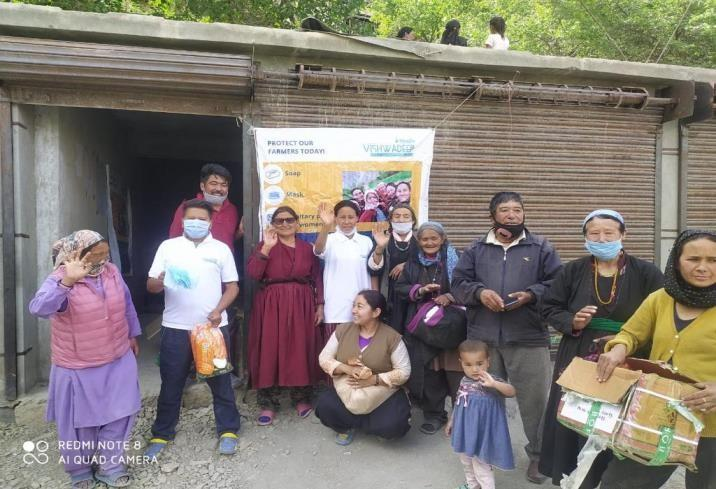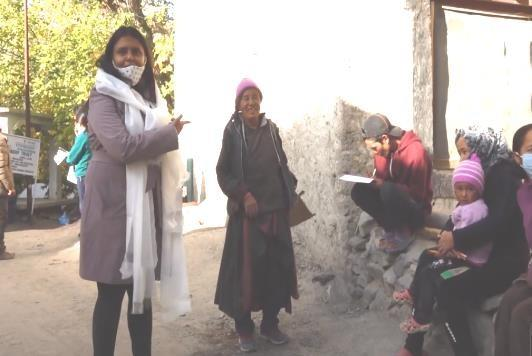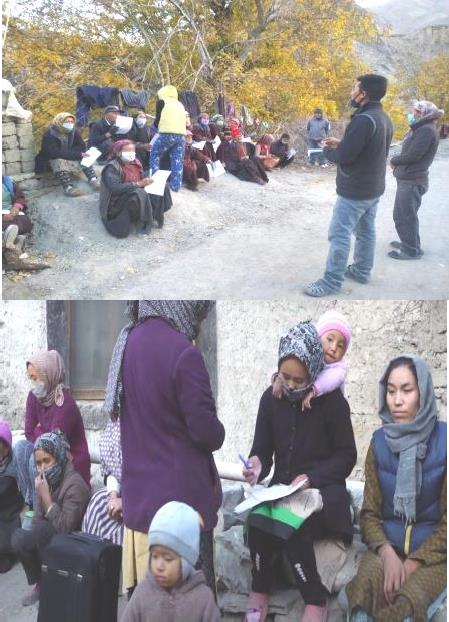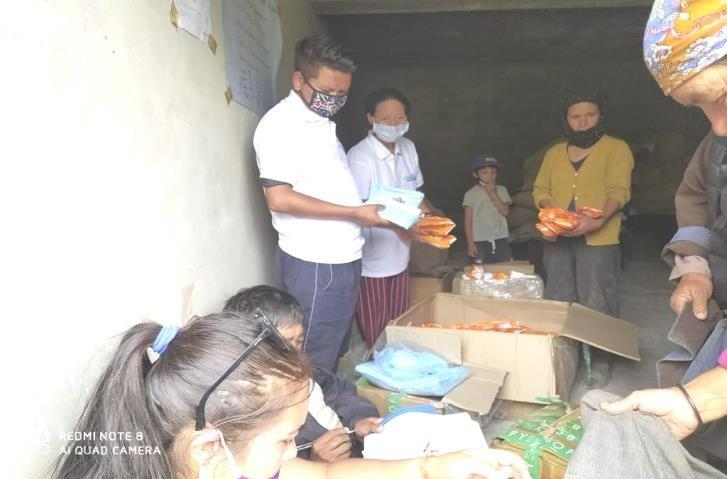With my experience having worked in hilly regions of Ladakh, I have often witnessed that last mile distribution of any kind of technology or even field testing and training when it is done free of cost then it is seldom utilized fully by the communities because they start perceiving it as a token or a charitable initiative, even if it is considered a charitable initiative, our NGO- Vishwadeep Trust has a

vision of empowering women farmers and tribal communities to fully take ownership of everything that has been given to them especially in the time of pandemic or time and againLadakh faces flash floods and several other crises that are often not talked about in the media. As the media only focuses on crime and entertainment, 69% of media space is covered by crime and entertainment, with very little importance given to village development or Gram Vikas. Therefore it is important that we talk about these aspects, specially of community engagement via contribution, via learning, via development of self help groups.
I will take you back to my time in 2017 when my initiative received a global environment
facility small grant programme under UNDP OP5 cycle. Although it was a small a grant
of USD 50,000 we impacted each and every household in Takmachik.
❖ We had two major technologies to be given to women farmers- Portable low cost
indigenous solar cookers and solar dryers because that would greatly reduce indoor air
pollution and reduce drudgery of women farmers in mountain region therefore we
decided to distribute solar cooker boxes completely free of cost to reduce their
drudgery and economic load. Also it was the year of demonetisation, keeping in mind
all these conditions we distributed the solar cooker free of cost.
❖ Upon monitoring in 2018 we found that very few only 30 to 40% of population were
making the judicial use of solar cookers. And that made us think twice because it was
not an easy task to firstly distribute 70 solar cook boxes in remote region of Sham valley that is Takmachik and more so collecting members of household training them
on the uses and benefits in both Ladakhi language and Hindi.
❖ We tried our best to instill a sense of ownership however we did not charge them any
money. And to our surprise only 40% of population was making judicial use of it.
Out of those 40%, 22% turned it into a mini local enterprise and started providing
solar cooked organic bread and biscuits to nearby cafes and resorts. However the rest,
in some households we found that the solar cookers were used like a little suitcase or
they started putting different items in the cook boxes.
So it was a bit heart breaking for me because I was working with deep emotions and I wanted
to provide maximum feminine care to the hardworking organic farmers of Ladakh. It was
then that I decided that any purchase that crosses above 1000 rupees to any household, there
will be a small fee or a community contribution attached to it.
❖ Therefore the next time when we tried to distribute solar dryers in the region we made
sure that there would be a community contribution attached to it. Therefore next time
when we decide to distribute solar dryers in the region we made sure that the
community contribution of atleast 50%. So 50% would be from trust or GEF fund or
trust fund and 50% from the community or Sarpanch.
❖ To our surprise not only the solar dryers were a big hit in the region but there were
repeat orders of solar dryers in the coming years not only from the same village but
also from the adjacent villages.
So this is my conclusion that even in the G.B. Pant granted NMHS project we have given
solar dryers, however there were no restrictions or recommendation from MoEF&CC to take
community contribution as is the case with GEF. GEF always harps on projects sustainability
and ownership amongst community hence they really instill and harp on co-financing. Co-
financing is not a major part of NHMS project but still knowing the region, knowing people
reactions and acceptance towards any innovation whether frugal or modern it is my
recommendation and suggestion that community contribution is definitely a boon. There is
always some negative stereotyping that NGOs make money or this is a lady who is an
outsider to Ladakh and she is here to make money and go back to New Delhi etc. However
the community always showed and instill trust in me and therefore they repeatedly order
dryers, cookers and other things. So therefore my understanding of community contribution always says that community contribution towards technology specially for post harvest management guarantees project sustenance and guarantees a sense of ownership within the community and overall upliftment of women farmers and tribals. However, I truly believe that there should be no added pressure on the organisation or community, in our case, we had conducted a small pilot for the dryers and they were a success in the region, with repeat orders we also reiterated
conducted a small pilot for the dryers and they were a success in the region, with repeat orders we also reiterated
that contribution is a must. The community was happy to contribute as the innovation has positively impacted their agriculture related practices. In my most recent visit, I noticed great drudgery and workload on women in general in Ladakh, it was painful for me to remain silent. In the absence of labour for loading and offloading of our solar trays, we couldn’t find the usual labour force from Kashmir, Bihar and due to immense need I witnessed old woman shivering in cold and with very rough hands lifting the trays, carrying it on their back towards the truck for offloading. I had to raise my voice at the contractor , he said madam lay no option we have no labour due to corona , here man woman are equal “sab ek hai”.
This is the most cruel form of
equality where women are considered equal when they have
to lift agri stubble, solar trays. I had to be stern and say please let her sit and you boys should do the work, she is in her 60’s. The same way in Takmachik, all the farmers and village dwellers had nice, welcoming things to say about us especially for sending them relief kits in the month of June for COVID-19.
The ladies who always are full of love, seemed tired and had lost weight, with droopy eyes. I asked them the reason to which they said they have had less options to eat as most stores were closed and they had very few food items. I have in my ten years of association with Ladakh never seen the farmers in such a situation, also most hotels, home stays closed but what remained constant was their cheerful greeting of JullayKhamzanglay. In the last decade, I may not have made a lot of money or become very “successful” but I believe I have become a better, lesser harmful person. As a conservationist, I have noticed the shrinking of mountains, rising man animal conflict and divisive attitudes towards local population rising. Ladakh being my karmabhoomi, I strongly believe I learnt from the locals to not discriminate between Hindu / Buddhists and Muslims, they love Iran and never discriminate. There is a presence of Ladakh V/S Tibet which I try to water down with my interaction. It was difficult
for me to find a transcriptor for Bodhi, that also made me think how far we have come from our roots. What was most annoying was the UT restrictions related to COVID-19 that was restricting us to conduct trainings on the ground, the circulars kept changing every 15 days or so. Civil society faces many unspoken struggles even while implementing Govt. projects, we continued to look for alternatives like conducting virtual trainings but they are not as impactful as in person physical trainings. Every trainer and genuine teacher has a presence similar to Guru Shishya relationship, like Lord Rama with one glance and pointing one finger would control, spread his aura and teachings, similar to HH Dalai lama who radiates Panchsheel rays from a very large distance.
Some facts-
• Rural women have more limited access to productive resource, service education and employment opportunities while experiencing, excessive workloads and limited decision making power.
• Climate change impact women and men differently evidence shows that women are more likely to be food insecure than men in every region of the world. Transformative spirit after natural disaster hit in India, girls were more likely started and underweight than boys and in A.P, twice as many women as men reported eating less in response to drought. In Kenya, fetching water may use up to 85% of a woman’s daily energy intake; in times of drought women spend up to 8 hours a day in search by water.
• Worldwide, less than 15% of agricultural land is held by women. Women play a major role in agriculture accounting for 43% of the agricultural labour force in developing countries, a figure that rises up to more than 60% in parts of South Asia and in Africa.
• Plant breeding& conservation:-
Women have played an important role in – Conservation
efforts like-
o Seed Saving
o Growing
o Preserving underutilised Species.
These species also have high value of as potential gene sources in case of collapse of commercially suitable varieties, that helps decrease their vulnerabilities to climate shocks and improve food security.
case of collapse of commercially suitable varieties, that helps decrease their vulnerabilities to climate shocks and improve food security.
• Female farmers play important roles in maintaining knowledge about different plants varieties and deciding which crops to plant, particularly as many new migrate away from the farm. There empowerment can significantly contribute to building the household resilience to climate impacts.
• Women’s ownership of productive assets is positively linked to their uptake of climate smart practices and soil conservation techniques. For instance, where women have secured land rights, greater yield and increased food security are also observed.
• Increasing women’s awareness and access to information and knowledge about climate smart agriculture options will lead to greater uptake of these technologies and practices, and enhance the resilience of entire household and communities and food systems to climate related shocks and changes.

We work for upliftment of tribal population and women farmers in remote locations and provide relief during crises
 Login
Login  Register
Register 






